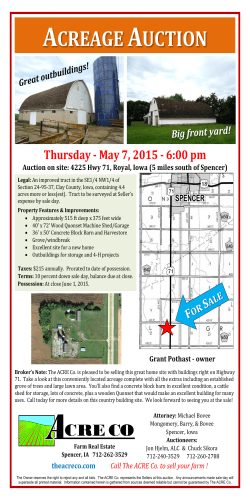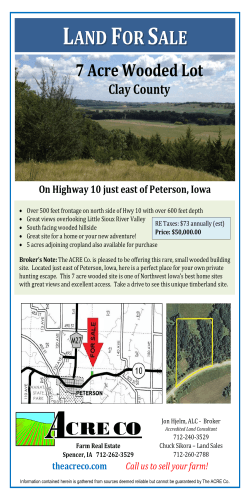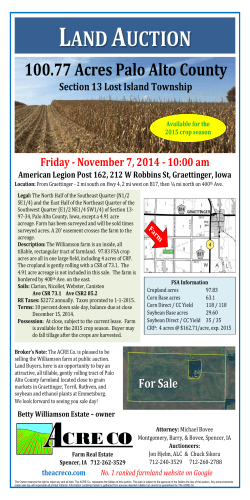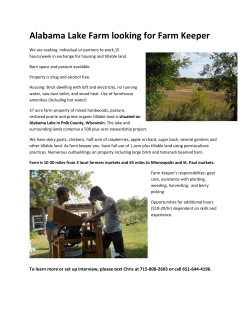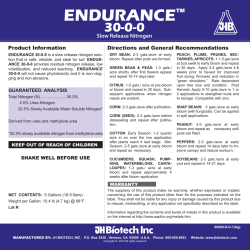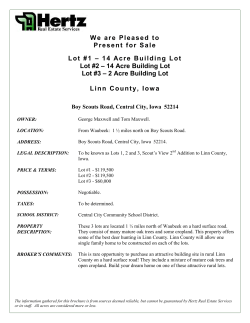
2015-16 IPCP Schedule A
Herbicides permitted for use under the Invasive Plant Control Program 2015-16 Schedule A Accepted Herbicide Options for Selected Noxious and Prohibited Weeds Note: the order of appearance of these products in the following list does not constitute a preference of the use of one product over the other. Please select the most appropriate product for the weeds being treated. Arsenal (Reg #23713); Arsenal Powerline (Reg.#30203) - Active ingredient: imazapyr. May be used in bare ground treatments only. Will kill nearly all vegetation contacted. Legumes may be slightly tolerant. Continues to prevent the emergence of weed seedlings due to soil residues. Very short buffer to water on the label. Will require permit from Saskatchewan environment. May be applied at 1.2 L/acre (or backpack at 30 mL/1L water). Several weeds have developed resistance to this class of herbicides (i.e. kochia) and will not be controlled. May be mixed with glyphosate and/or Banvel VM for control of these weeds. Eligible Noxious Weeds: • Leafy spurge • Yellow toadflax • Ox-eye Daisy • Field bindweed • Common Burdock • Bladder campion Aspect (Reg#31641); Grazon XC (Reg#31642) – Active ingredient: picloram + 2,4-D choline salt. Aspect is for use in industrial areas and Grazon XC is for use in range and pasture areas. Both products selectively control broadleaf weeds and brush in perennial grass cover. Both products have residual characteristics that may negatively impact sensitive species for one to two years after application. Eligible Noxious Weeds: • Common burdock (1.89 L/acre) Clearview (Reg#29752); Sightline (Reg#30409) – Active ingredient: aminopyralid + metsulfuron (Sightline also contains fluroxypyr for control of Group 2 resistant kochia or cleavers) Clearview and Sightline are for use in non-crop areas (roadsides, ditches, commercial land, right-of-ways etc.) and may be used occasionally in Range and Pasture areas for control of invasive species. Because these products are essentially a combination of Milestone and Escort, they have residual characteristics that may negatively impact sensitive species for one to two years after application. Plants in the legume and sunflower families are the most sensitive to these products. Eligible Weeds: • Absinthe (Clearview or Sightline A @ 93 g/acre; Sightline B @ 0.34 L/acre) • Ox-eye daisy (Clearview or Sightline A @ 55 g/acre; Sightline @ 0.34 L/acre) • Common tansy (Clearview or Sightline A @ 55 g/acre; Sightline @ 0.34 L/acre) • Black henbane (Clearview or Sightline A @ 81 g/acre; Sightline @ 0.34 L/acre) • Wild parsnip (Clearview or Sightline A @ 81 g/acre; Sightline @ 0.34 L/acre) 1 Herbicides permitted for use under the Invasive Plant Control Program 2015-16 Schedule A Dicamba 480 g/L formulations (various)- Active ingredient: dicamba. For use in both range and pasture as well as non-crop areas. For selective control of broadleaf weeds in perennial grass covered areas. These products may leave a residue for at least a portion of the growing season that will impact sensitive plants seeded into the area. These products are soluble in water and caution should be used when applying to very sandy land with shallow ground water. Eligible Weeds: • Field bindweed (0.85 L/acre at the flowering stage) Escort (Reg#23005) – Active ingredient: metsulfuron. May be used for selective control in perennial grass areas. Use the rate specified for specific species plus non-ionic surfactant (Agral 90, Surf 92, Prosurf, etc.) at 20 mL for each 10 L of spray solution. Escort has residual characteristics that may negatively impact sensitive species for four or more years after application. Eligible Noxious Weeds: • Common Tansy (8 g/acre) Glyphosate (Reg# various brands) – May be used on bare ground or prior to harvest of certain crops. Will kill all vegetation that is contacted. No residual efficacy. A use rate of 360 g acid equivalent (ae) per acre (see pg. 179 of Saskatchewan Agriculture Guide to Crop Protection for equivalent volumes of specific formulations) may be used prior to harvest of annual crops, hay to be removed from production or to bare ground. Eligible Noxious Weeds: • Field bindweed • Yellow Toadflax • Absinthe • Hoary cress Grazon XC (see Aspect above) Milestone (Reg#28517) – Active ingredient: aminopyralid. Milestone is for use in non-crop areas and may be used occasionally in Range and Pasture areas for control of invasive species. Milestone will control of broadleaf species in permanent perennial grass areas. Milestone has residual characteristics that may negatively impact sensitive species for one to two years after application. The addition of 2,4-D 600 Amine at 1 L/acre will enhance control. For Range and Pasture use see Restore II. Eligible Noxious Weeds: • Absinthe (at 0.2 L/acre alone or 0.15 L/acre + 2,4-D 600 Amine at 0.77 L/acre) • Ox-eye daisy (117 mL/acre) • Hoary cress ( at 117 mL/acre + 2,4-D 600 Amine at 0.6 L/acre) • Common tansy (at 0.2 L/acre + 2,4-D 600 Amine at 1 L/acre) 2 Herbicides permitted for use under the Invasive Plant Control Program 2015-16 Schedule A Navius VM (Reg#31382) – Active ingredient: aminocyclopyrachlor + metsulfuron. May be used for selective broadleaf weed control in grassy areas as well as brush at higher rates. Only for use on industrial sites such as rights of way (road, pipeline, rail), non-irrigated ditchbanks, well sites yard sites, etc. – may not be used in range or pasture. Do not allow treated areas to be cut for hay or grazed by livestock as this product is not registered for this use. A rate of 67.6 g/acre is recommended (8.35 g per 10 L water treats 500 sq. metres). A measuring cylinder is included in each package of Navius VM and is for measuring Navius VM only. An adjuvant must be added to the spray mixture for proper activity. Non-ionic surfactants (Agral 90, Surf 92, ProSurf, etc.) must be added at 2.5 mL per 1 L of spray solution or either Merge or a Crop Oil Concentrate (i.e. Assist, Score, Superior Oil Concentrate, etc.) must be added at 10 mL per L of spray solution. Applications must be made in a minimum of 81 L/acre of water for adequate coverage. Upwind spraying must stay back 5 m from aquatic habitats and shallow water bodies less than 1 m deep or 2 m from water deeper than 1 m. Applications must stay back from sensitive land-dwelling plants by 45 m. The buffer to land-dwelling plants is not required on rights-of-way, but precautions should still be taken to avoid damage from drift. Avoid applying over the roots of trees (typically equal to the height of the tree from the trunk). Eligible Noxious Weeds: • Leafy spurge • Common Tansy • Ox-eye daisy Reclaim II (Reg#29752) – Active Ingredients: aminopyralid, metsulfuron and 2,4D. Reclaim is for use in Range and Pasture areas for control of invasive species. Reclaim will control of broadleaf species in permanent perennial grass areas. Reclaim has residual characteristics that may negatively impact sensitive species for one to two years after application. The use of a non-ionic surfactant (Agral 90, Surf 92, Citowett Plus, Prosurf, etc.) at 20 mL for each 10 L of spray solution. For Industrial use also see Clearview. Eligible Noxious Weeds: • Reclaim II A - 55 g/acre + Reclaim II B – 0.69 L/acre; o Absinthe o Hoary Cress o Russian knapweed o Common tansy o Ox-eye daisy (pre-bud) Restore II (Reg#28517) – Active ingredient: aminopyralid and 2,4-D. Restore II is for use in non-crop areas and may be used occasionally in Range and Pasture areas for control of invasive species. Restore II will control of broadleaf species in permanent perennial grass areas. Restore II has residual characteristics that may negatively impact sensitive species for one to two years after application. For Industrial uses see Milestone. Eligible Noxious Weeds: • Absinthe (0.97 L/acre) • Burdock (0.97 L/acre) • Field Bindweed (0.97 L/acre) • Hoary cress (0.97 L/acre) • Ox-eye daisy (0.57 L/acre) Sightline (see Clearview above) 3 Herbicides permitted for use under the Invasive Plant Control Program 2015-16 Schedule A Tordon 22K (Reg#9005) – Active ingredient: picloram. May be used for selective control in permanent grass areas. The maximum rate of 3.6 L/acre (90mL/18L of water over 100 sqm) may be applied by hand application equipment only and may only be applied to 50% of any two acre parcel. Rates of 1.9 L/acre may be used for applications may over larger areas. This product is mobile in water and may leach into groundwater if applied to sandy soils overlying shallow ground water. Tordon may also leave a residue in the soil that will impede the growth of sensitive crops for several years. Eligible Noxious Weeds: • Leafy spurge (highest label rates) • Russian knapweed (1.9 L/acre rate) • Yellow toadflax (highest label rates) • Field bindweed (highest label rates) Truvist (Reg#30920) – Active ingredient: aminocyclopyrachlor + chlorsufuron. May be used for selective broadleaf weed control in grassy areas or mixed with non-selective soil persistent herbicides for bare ground sites. Only for use on industrial sites such as rights of way (road, pipeline, rail), non-irrigated ditchbanks, well sites yard sites, etc. – may not be used in range or pasture. Do not allow treated areas to be cut for hay or grazed by livestock this product is not registered for this use. A rate of 68 g/acre is recommended (8.4 g per 10 L water treats 500 sq. metres). A measuring cylinder is included in each package of Truvist and is for measuring Truvist only. An adjuvant must be added to the spray mixture for proper activity. Non-ionic surfactants (Agral 90, Surf 92, ProSurf, etc.) must be added at 2.5 mL per 1 L of spray solution or either Merge or a Crop Oil Concentrate (i.e. Assist, Score, Superior Oil Concentrate, etc.) must be added at 10 mL per L of spray solution. Applications must be made in a minimum of 81 L/acre of water for adequate coverage. Spraying must stay back 2 m from aquatic habitats and shallow water bodies less than 1 m deep or 1 m from water deeper than 1 m. Applications must stay back from sensitive land-dwelling plants by 25 m. The buffer to land-dwelling plants is not required on rights-of-way, but precautions should still be taken to avoid damage from drift. Avoid applying over the roots of trees (typically equal to the height of the tree from the trunk). Eligible Weeds: • Leafy spurge • Common Tansy • Field bindweed • Ox-eye daisy • Bladder campion • Wild parsnip 4 Prohibited Weeds Because prohibited weeds are rare or not currently found in Saskatchewan, registered control options may not have been developed in Canada yet. In accordance with The Weed Control Act, RMs are required to notify Crops and Irrigation Branch upon the discovery of a prohibited weed and at that time an appropriate control option will be investigated and approved. For control options for Prohibited weeds or assistance in confirming identification please contact the Provincial Weed Specialist at: (306) 787-4673 or [email protected] Note on Prohibited Weeds Prohibited Weeds are either not currently in Saskatchewan, or are only recently introduced and very rare. If producers look through the list of Prohibited Weeds, there will be very few that they will recognize since for the most part, these species are not found in Saskatchewan yet. It is essential that these weeds are discovered as soon as possible after they enter the province, quarantined when they are found, and eradicated using the most effective means possible, to prevent them from gaining a foothold. (1) The following plants are designated as Prohibited Weeds in Saskatchewan: Common Name barberry, common bartsia, red chervil, wild crupina, common cupgrass, woolly darnel foxtail, giant goatgrass, jointed halogeton hemlock, poison hogweed, giant hound’s-tongue knapweed, diffuse knapweed, spotted knapweed, squarrose mustard, garlic pepperweed, perennial pondweed, curly-leaved puncturevine rue, African rush, flowering saltcedar scabious, field star-thistle, yellow toadflax, Dalmatian water-milfoil, Eurasian floating heart, yellow Botanical Name Berberis vulgaris L., Odontites serotina Dum. Anthriscus sylvestris (L.) Hoffm. Crupina vulgaris Cass. Eriochloa villosa (Thunb.) Kunth Lolium temulentum L. Setaria faberi Herrm. Aegilops cylindrical Host Halogeton glomeratus (M. Bieb.) C.A. Mey. Conium maculatum L. Heracleum mantegazzianum Sommier & Levier Cynoglossum officinale L. Centaurea diffusa Lam. Centaurea stobe L.(=Centaurea biebersteinii DC) Centaurea virgata Lam. Allaria petiolata (M. Bieb.) Cavara & Grande Lepidium latifolium L. Potamogeton crispus L. Tribulus terrestris L. Peganum harmala L. Butomus umbellatus L. Tamarix sp Knautia arvensis (L.) Coult. Centaurea solstitialis L. Linaria dalmatica Myriophyllum spicatum L. Nymphoides peltata (S.G. Gmel.) Kuntze 5
© Copyright 2025
